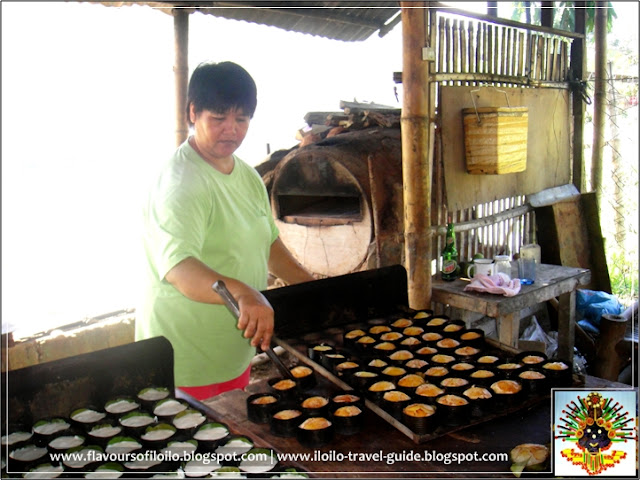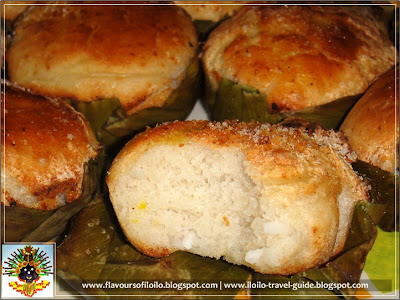I have always associated bingka with Semana Santa for it is only during the Lenten season that I got to taste a galore of bingkas in my hometown.
What makes the Sta. Barbara bingka different from bingkas from other towns is how it looks and tastes more like a puto rather than traditional bingka. So one day, I went on a quest to discover how these bingkas are made.
MEET THE BINGKA QUEEN
She might not refer herself as one but Maria Shielley Simoy or popularly called Leling is undoubtedly the queen of bingka in Sta. Barbara. “It was my grandmother who started this native delicacies business decades ago and it was the bingka recipe that became a big hit” Leling opens up.
Like most bingkahans, they only used to make bingka during Lent then but seeing the great potential of the business, Leling started to make their famous bingka all year round. “I start making bingka around 11am, preparing the (makeshift) oven – just like the conventional one, it needs to be preheated” she explains. “But on Tuesdays and Fridays, we start around 9am so that we can sell during the town’s market days.
LELING’S SPECIAL BINGKA RECIPE
Leling unselfishly shares her recipe and it begins with a rice flour mix. “We soak the rice in water overnight and we grind it the following day” she says. She then mixes a pampa-alsa which makes her bingka recipe much like that of puto. She completes her recipe by adding whole eggs, sugar and milk.
As she mixed a tubful of her concoction I noticed there were no coconut strips. I was about to ask why, when she sprinkled some coconut on top of her mix then placed a big scoop of it in the bingka mold fitted with banana leaves.
“If we mix the coconut strips, they will just settle in the bottom thus giving inconsistent amount of coconut to some of the bingka” she explains. Thus putting the coconut strips on top assures that each bingka has just the right amount of coconut strip between bites.
As she mixed a tubful of her concoction I noticed there were no coconut strips. I was about to ask why, when she sprinkled some coconut on top of her mix then placed a big scoop of it in the bingka mold fitted with banana leaves.
“If we mix the coconut strips, they will just settle in the bottom thus giving inconsistent amount of coconut to some of the bingka” she explains. Thus putting the coconut strips on top assures that each bingka has just the right amount of coconut strip between bites.
A RUB AND A SPRINKLE
I counted around 8 minutes, after she placed her bingkas inside the oven, when she opened it again. ”I check the tops if they are already crisp, with some noticeable “cracks” in them” she said. “We then brush liquefied margarine then sprinkle sugar crystals, then its back to the oven to finish the cooking”
When the tops turn golden brown, she takes them out of the oven. But Leling makes sure each bingka is perfect thus she handpicks those which are not yet as golden brown and they go back to the oven for a few more minutes.
Her oven is good enough to cook around 60 bingkas per batch. While one lot is inside the oven she unmolds the cooked ones unto the table. After which the molds are cooled off then fresh banana leaves are then placed into the mold and the cycle continues.
Her oven is good enough to cook around 60 bingkas per batch. While one lot is inside the oven she unmolds the cooked ones unto the table. After which the molds are cooled off then fresh banana leaves are then placed into the mold and the cycle continues.
THE MANUGLIBOD CONCEPT
These bingkas are placed in styro boxes in order for them to remain hot and also make them more convenient to be sold around town. Then came Junica and Ronica, two of Leling’s manuglibods (vendors) each carrying an empty styro box. Usually it only takes them a few hours to sell these bingkas but they can sell up to 4 boxes if transportation is available especially in far baranggays.
Leling makes around a thousand bingkas daily, even more if she has big orders. “We also take special orders from our suki too” she says. “They just supply the additional ingredients - like more eggs and milk, to our mixture”. And during rainy days, her bingka orders increase.
For only 5 pesos each, these bingkas have played different roles for different people. For us who have tried them, it brings back our childhood food memories. For those who haven’t, it’s a gastronomic adventure of having a different kind of bingka experience. For her manuglibods, it is a way of earning a living to support their respective families.
And for Leling, aside from augmenting their source of income that send her children to school, it was also a way of continuing her family’s legacy and making these puto-like bingka, the pride of Sta. Barbara!
Leling’s Bingkahan is located along Taft Street in Sta. Barbara, Iloilo and is open Monday’s to Saturdays from 11am to 3pm.


















